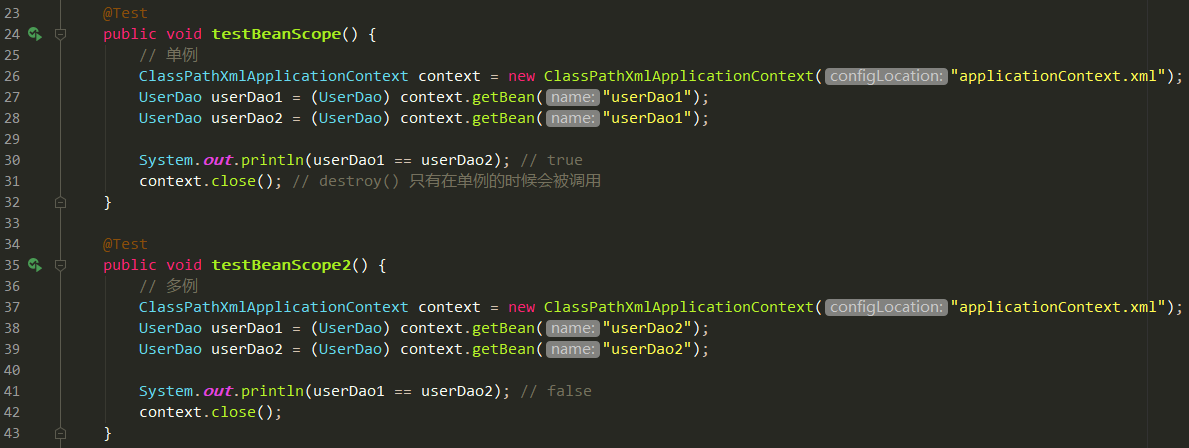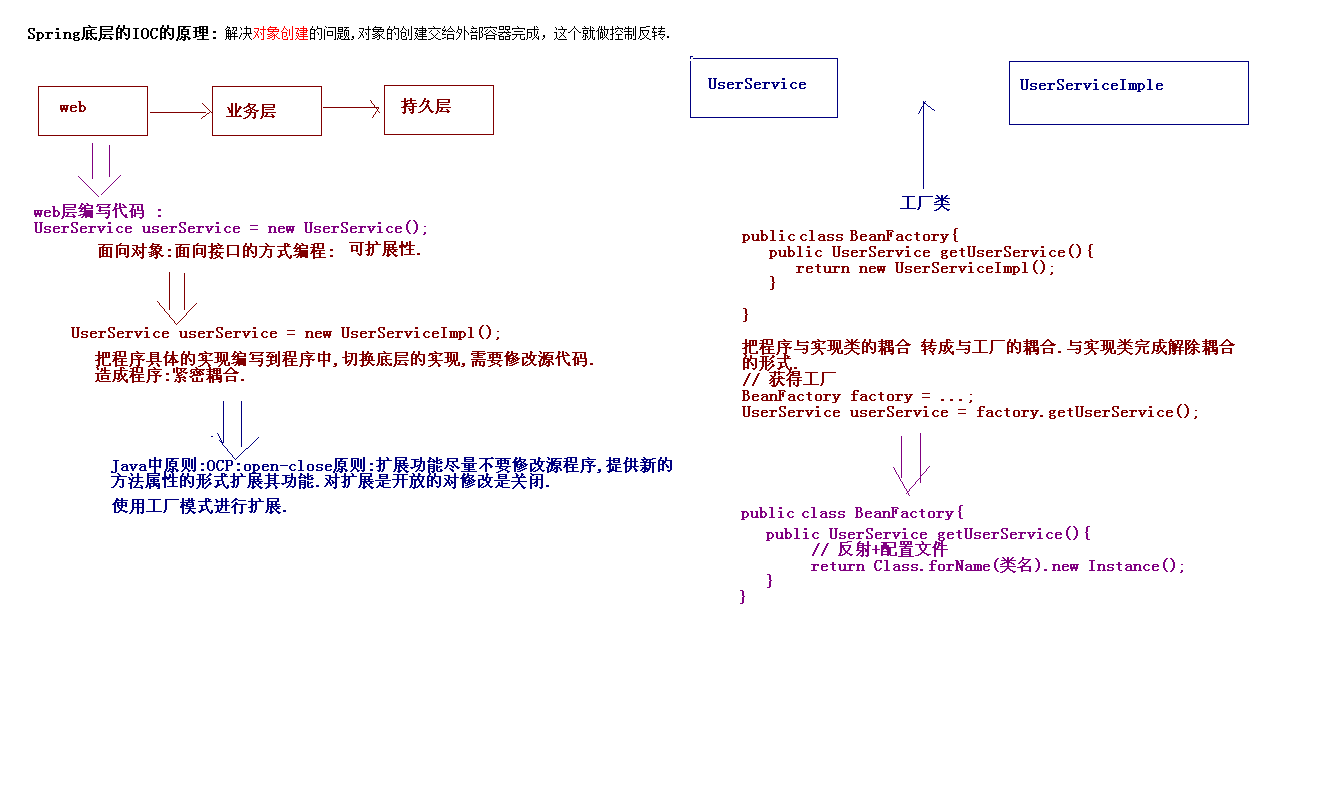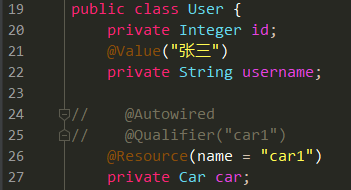01-Spring IoC (DI)

参考资料:https://lfvepclr.gitbooks.io/spring-framework-5-doc-cn/content/
1. 引言
1.1 原生web开发的弊端
传统Web开发存在硬编码所造成的过度程序耦合(例如:Service中作为属性Dao对象)。
部分Java EE API较为复杂,使用效率低(例如:JDBC开发步骤)。
侵入性强,移植性差(例如:DAO实现的更换,从Connection到SqlSession)。
2. Spring 框架
2.1 概念
什么是Spring
Spring是分层的 JavaSE/EE full-stack(一站式) 轻量级开源框架,以 IoC(Inverse of Control 控制反转)和 AOP(Aspect Oriented Programming面向切面编程) 为内核。分层:
JavaEE 的三层结构 :web层、业务层、数据访问层(持久层,集成层)
Struts2 是 web 层基于 MVC 设计模式框架。
Mybatis、Hibernate 是持久的一个 ORM 的框架。
一站式:
Spring框架有对三层的每层解决方案:
web层:Spring MVC
持久层:JDBC Template
业务层:Spring的Bean管理Spring的好处:
方便解耦,简化开发
Spring就是一个大工厂,可以将所有对象创建和依赖关系维护,交给Spring管理
AOP编程的支持
Spring提供面向切面编程,可以方便的实现对程序进行权限拦截、运行监控等功能
声明式事务的支持
只需要通过配置就可以完成对事务的管理,而无需手动编程
方便程序的测试
Spring对 Junit4 支持,可以通过注解方便的测试 Spring 程序
方便集成各种优秀框架
Spring 不排斥各种优秀的开源框架,其内部提供了对各种优秀框架(如:Struts、Hibernate、MyBatis、Quartz等)的直接支持
Spring 对 JavaEE 开发中非常难用的一些API(JDBC、JavaMail、远程调用等),都提供了封装,降低JavaEE API的使用难度- 测试工具:junit、postman、postwoman、swagger
安全框架:shiro 和 spring security
容器引擎:docker 和 k8s
Spring初版:interface21
- 测试工具:junit、postman、postwoman、swagger
2.2 访问与下载
官方网站:https://spring.io/
下载地址:http://repo.spring.io/release/org/springframework/spring/
3. Spring 架构组成
Spring架构由诸多模块组成,可分类为
核心技术:
依赖注入,事件,资源,i18n(国际化),验证,数据绑定,类型转换,SpEL,AOP。测试:模拟对象,TestContext框架,Spring MVC测试,WebTestClient。
数据访问:
事务,DAO支持,JDBC,ORM,封送XML。Spring MVC 和 Spring WebFlux Web框架。
集成:远程处理,JMS,JCA,JMX,电子邮件,任务,调度,缓存。
语言:Kotlin,Groovy,动态语言。
| Spring架构组成 |
|---|
 |
Spring 依赖:
| GroupId | ArtifactId | 说明 |
|---|---|---|
| org.springframework | spring-beans |
Beans 支持,包含 Groovy |
| org.springframework | spring-aop |
基于代理的AOP支持 |
| org.springframework | spring-aspects |
基于AspectJ 的切面 |
| org.springframework | spring-context |
应用上下文运行时,包括调度和远程抽象 |
| org.springframework | spring-context-support |
支持将常见的第三方类库集成到 Spring 应用上下文 |
| org.springframework | spring-core |
其他模块所依赖的核心模块 |
| org.springframework | spring-expression |
Spring 表达式语言,SpEL |
| org.springframework | spring-instrument | JVM 引导的仪表(监测器)代理 |
| org.springframework | spring-instrument-tomcat | Tomcat 的仪表(监测器)代理 |
| org.springframework | spring-jdbc |
支持包括数据源设置和 JDBC 访问支持 |
| org.springframework | spring-jms | 支持包括发送/接收JMS消息的助手类 |
| org.springframework | spring-messaging | 对消息架构和协议的支持 |
| org.springframework | spring-orm | 对象/关系映射,包括对 JPA 和 Hibernate 的支持 |
| org.springframework | spring-oxm | 对象/XML 映射(Object/XML Mapping,OXM) |
| org.springframework | spring-test |
单元测试和集成测试支持组件 |
| org.springframework | spring-tx |
事务基础组件,包括对 DAO 的支持及 JCA 的集成 |
| org.springframework | spring-web |
web支持包,包括客户端及web远程调用 |
| org.springframework | spring-webmvc |
REST web 服务及 web 应用的 MVC 实现 |
| org.springframework | spring-webmvc-portlet | 用于 Portlet 环境的MVC实现 |
| org.springframework | spring-websocket | WebSocket 和 SockJS 实现,包括对 STOMP 的支持 |
| org.springframework | spring-jcl |
Jakarta Commons Logging 日志系统 |
4. Spring 入门
4.1 导入依赖
1 | |
4.2 创建applicationContext.xml
在 \src\main\resources 目录下:
1 | |
4.3 测试
使用 ClassPathXmlApplicationContext(String filename) 来获取 context 对象,进而获取 Bean 对象的实例(本质是反射原理)。
1 | |
4.4 ApplicationContext与BeanFactory
ApplicationContext: 它在构建核心容器时,创建对象采取的策略是采用立即加载的方式。
BeanFactory: 它在构建核心容器时,创建对象采取的策略是采用延迟加载的方式。
ApplicationContext 对 BeanFactory 提供了扩展 :
- 国际化处理
- 事件传递
- Bean 自动装配
- 各种不同应用层的 Context 实现
- 早期开发使用 BeanFactory
5. Spring bean 管理
5.1 创建bean×3
<bean> 元素: 使用该元素描述需要 spring 容器管理的对象
class 属性: 被管理对象的完整类名
name 属性: 给被管理的对象起个名字,获得对象时根据该名称获得对象
id 属性: 与 name 属性作用相同
创建方式:
第一种方式:使用
默认构造函数创建。在spring的配置文件中使用bean标签,配以id和class属性之后,且没有其他属性和标签时。采用的就是默认构造函数创建bean对象,此时如果类中没有默认构造函数,则对象无法创建。
1 | |
第二种方式: 使用普通工厂中的
方法创建对象使用某个类中的方法创建对象,并存入spring容器
1 | |
第三种方式:使用工厂中的
静态方法创建对象使用某个类中的静态方法创建对象,并存入spring容器
1 | |
5.2 bean 作用范围
- scope 属性:用于指定bean的作用范围。取值: 常用的就是单例的和多例的
- singleton:每个 Spring IoC 容器仅有一个单实例。
单例的(默认值) - prototype:每次请求都会产生一个新的实例。 多例的(
Struts2中 action 默认是多例的) - request:每一次 HTTP 请求都会产生一个新的实例,并且该 bean 仅在当前 HTTP 请求内有效。作用于web应用的请求范围
- session:每一次 HTTP 请求都会产生一个新的 bean,同时该 bean 仅在当前 HTTP session 内有效。作用于web应用的会话范围
- global-session:作用于集群环境的会话范围(全局会话范围),当不是集群环境时,它就是 session。
- singleton:每个 Spring IoC 容器仅有一个单实例。
1 | |
5.3 bean 生命周期
生命周期属性:
- init-method 属性:配置一个方法作为生命周期初始化方法,Spring会在对象创建之后立即调用,
- destory-method 属性:配置一个方法作为生命周期的销毁方法,Spring容器在关闭并销毁所有容器中的对象之前调用
- lazy-init 属性:配置当前使用的 applicationContext 对象为
懒汉式单例(使用单例时可配置)
注意:
- close() 方法为
子类独有,父类无法直接调用;- close 释放资源时,destory-method 对应的方法只在
单例中有效。
1 | |

6. Spring 依赖注入
Dependency Injection(DI),依赖注入:
IoC 的作用:降低程序间的耦合(依赖关系)
依赖关系管理:以后都交给spring来维护,在当前类需要用到其他类的对象,由spring为提供,只需要在配置文件中说明
依赖关系维护:就叫做依赖注入。
能注入的数据:
- 基本类型(包装类型)和String
- 其他bean类型(在配置文件中或者注解配置过的bean)
- 复杂类型/集合类型

注入方式:
第一种:使用构造函数提供注入
第二种:使用set方法 提供注入
第三种:使用注解提供注入
6.1 构造函数注入
bean标签的内部,使用子标签:<constructor-arg>
标签中的属性:
name:用于指定给构造函数中指定名称的参数赋值
index:用于指定要注入的数据给构造函数中指定索引位置的参数赋值。索引的位置是从 0 开始
**
value**:用于提供基本类型和 String 类型的数据**
ref**:用于指定其他的 bean 类型数据。它指的就是在 Spring 的 Ioc 核心容器中出现过的 bean 对象type:用于指定要注入的数据的数据类型,该数据类型也是构造函数中某个或某些参数的类型(可省略)
注意:可只提供 name 和 value/ref 属性,type、index 可自动推断
优势:在获取 bean 对象时,注入数据是必须的操作,否则对象无法创建成功。
弊端:改变了 bean 对象的实例化方式,使在创建对象时,如果用不到这些数据,也必须提供。
1 | |
6.2 set 方法注入
bean标签的内部,使用子标签:<property>
标签中的属性:
- name:用于指定注入时所调用的 set 方法名称
- value:用于提供基本类型和 String 类型的数据
- ref:用于指定其他的 bean 类型数据。它指的就是在 Spring 的 Ioc 核心容器中出现过的 bean 对象
优势:创建对象时没有明确的限制,可以直接使用默认构造函数
弊端:如果有某个成员必须有值,则获取对象是有可能 set 方法没有执行。
1 | |
6.3 注解方式注入(★)
- 用于创建对象的注解
他们的作用就和在XML配置文件中编写一个<bean>标签实现的功能是一样的- @Component : 用于把当前类对象存入 spring 容器中,pojo/entiry/bean
- value 属性:用于指定 bean 的 id 。
当不写时,它的默认值是当前类名的首字母小写形式。
- value 属性:用于指定 bean 的 id 。
- @Controller :一般用在表现层,controller
- @Service :一般用在业务层,service
- @Repository :一般用在持久层,dao
- @Component : 用于把当前类对象存入 spring 容器中,pojo/entiry/bean
以上三个注解的作用和属性与 Component 相同,是 Spring 框架为提供明确的三层使用的注解。
扫描注解:即在 applicationContext.xml 中的添加 context 约束。
1 | |
- 用于注入数据的
他们的作用就和在xml配置文件中的bean标签中写一个<property>标签的作用是一样的- @Autowired : 自动按照类型注入
- @Qualifier : 在按照类中注入的基础之上再按照名称注入,value属性:用于指定注入bean的id,
一般与 @Autowired 注解结合使用 - @Resource : 直接按照 bean 的 id 注入,等价于@Autowired+@Qualifier。它可以独立使用,name属性:用于指定bean的id,name必须书写(
如果该注解无法使用,则需要导入 javax.annotation-api 依赖) - @Value:用于注入基本类型和String类型的数据

注意:
该三个注入都只能注入其他 bean 类型的数据,而 基本类型和String类型 无法使用上述注解实现。
另外,
集合类型的注入只能通过 XML 来实现。因为 Resource 注解是 J2EE 的,而不是 Spring 本身的,所以在使用时需要在 pom.xml 中导入javax.annotation-api依赖。
1 | |
1 | |
- 用于改变作用范围的
作用和在 bean 标签中使用 scope 属性实现的功能是一样的。- @scope :指定bean的作用范围
- value :指定范围的取值。常用取值:singleton(默认单例) prototype
- @scope :指定bean的作用范围
1 | |
- 和生命周期相关
作用和在 bean 标签中使用 init-method 和 destroy-methode 的作用是一样的。- @PreDestroy:指定销毁方法(同样只在单例模式下生效,即 @Scope 或 @Scope(“singleton”))
- @PostConstruct:指定初始化方法
1 | |
6.4 集合类型注入方式
用于给List结构集合注入的标签:
<list><array><set>
用于个Map结构集合注入的标签:
<map><props>
1 | |
7. Spring 引入其他 xml
在当前 applicationContext.xml 配置文件中引入其他配置文件,如 bean.xml
1 | |